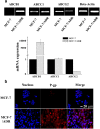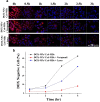Overcoming anticancer resistance by photodynamic therapy-related efflux pump deactivation and ultrasound-mediated improved drug delivery efficiency
- PMID: 32897469
- PMCID: PMC7479087
- DOI: 10.1186/s40580-020-00241-8
Overcoming anticancer resistance by photodynamic therapy-related efflux pump deactivation and ultrasound-mediated improved drug delivery efficiency
Abstract
One of the major obstacles to successful chemotherapy is multi-drug resistance (MDR). A multi-drug resistant cancerous cell abnormally overexpresses membrane transporters that pump anticancer drugs out of the cell, resulting in low anticancer drug delivery efficiency. To overcome the limitation, many attempts have been performed to inhibit the abilities of efflux receptors chemically or genetically or to increase the delivery efficiency of anticancer drugs. However, the results have not yet been satisfactory. In this study, we developed nanoparticle-microbubble complexes (DOX-NPs/Ce6-MBs) by conjugating doxorubicin loaded human serum albumin nanoparticles (DOX-NPs) onto the surface of Chlorin e6 encapsulated microbubbles (Ce6-MBs) in order to maximize anticancer efficiency by overcoming MDR. Under the ultrasound irradiation, DOX-NPs and Ce6 encapsulating self-assembled liposomes or micelles were effectively delivered into the cells due to the sonoporation effect caused by the microbubble cavitation. At the same time, reactive oxygen (ROS) generated from intracellularly delivered Ce6 by laser irradiation arrested the activity of ABCG2 efflux receptor overexpressed in doxorubicin-resistant breast cancer cells (MCF-7/ADR), resulting in increased the chemotherapy efficacy. In addition, the total number of side population cells that exhibit the properties of cancer stem-like cells were also reduced by the combination of photodynamic therapy and chemotherapy. In conclusion, DOX-NPs/Ce6-MBs will provide a platform for simultaneously overcoming MDR and increasing drug delivery and therefore, treatment efficiency, under ultrasound irradiation.
Keywords: Efflux pump; Microbubble; Multidrug resistance; Nanomedicine; Side population; Sonoporation; Ultrasound.
Conflict of interest statement
The authors declare that they have no competing interests.
Figures








References
Grants and funding
LinkOut - more resources
Full Text Sources
Research Materials
